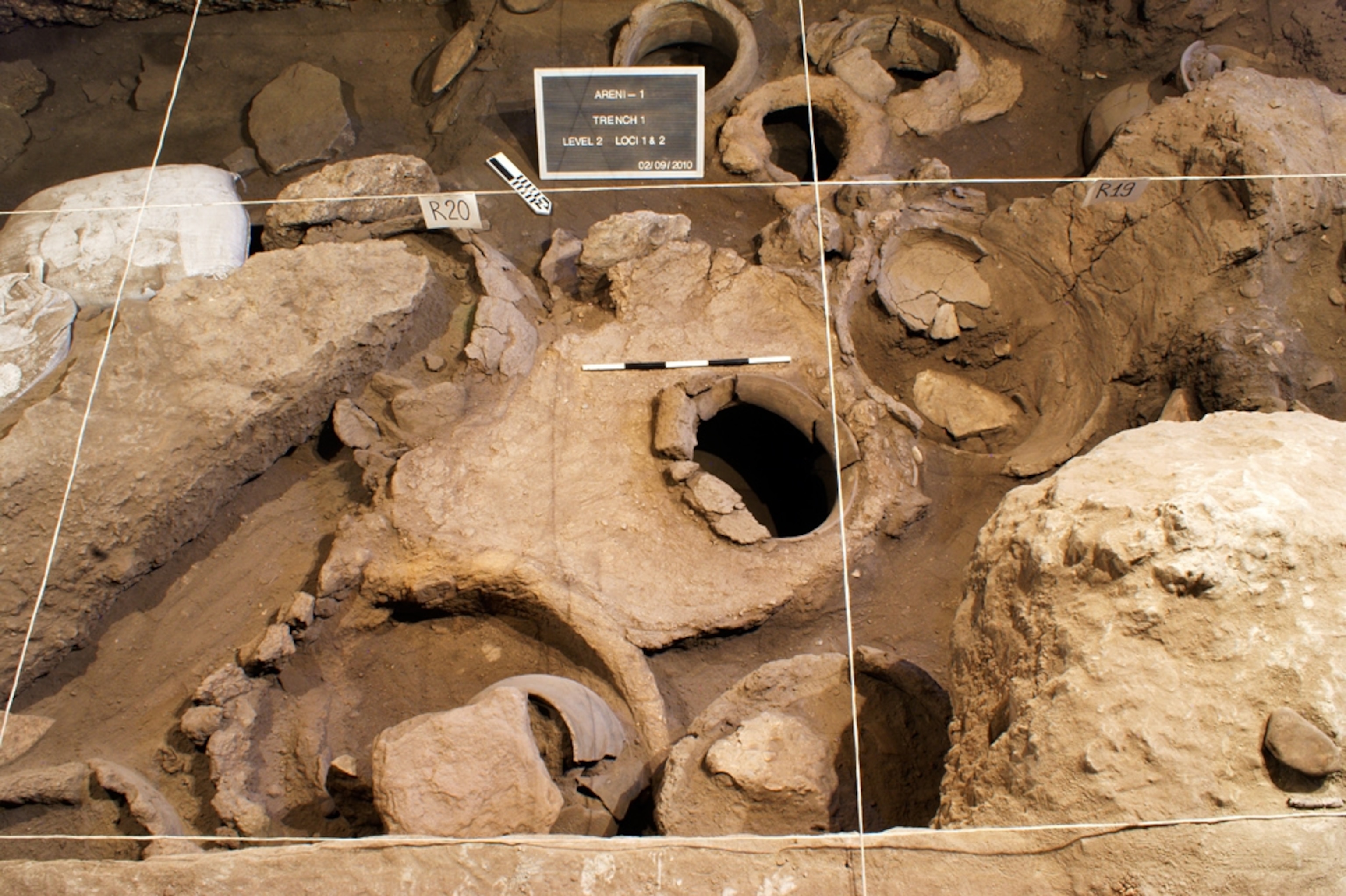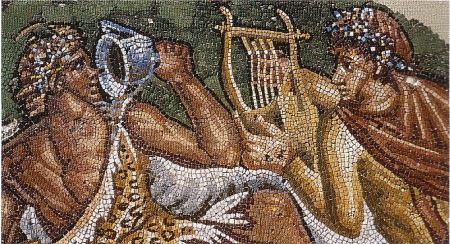History of Wine
Dictionary Definition
wine
/wʌɪn/
noun
an alcoholic drink made from fermented grape juice.
"he opened a bottle of red wine"
|
synonyms: |
vin de
table, vin ordinaire, vin du pays; informalplonk, vino, the
grape
|
Ancient History
·
The
earliest wine archaeobotanical evidence was found in Georgia, and date back 8,000
years to approximately 6,000 B.C.
· The earliest historical evidence of wine dates back 9,000 years to 7,000 B.C. China. Grapes were also wined with rice and other fruits.
· The spread of wine culture westwards is credited to the Phoenicians some 2,750 years in the past. The main vessel of transportation was the clay amphora.
· The use of wine in religion was significant in ancient mythology and religion. 3100 BC till 30 BC, wine symbolized blood in ancient Egypt.
· Ancient Romans planted vineyards in almost every settlement they’ve established.
\
·
77
AD The Roman Pliny the Elder writes “vino veritas” or “In wine there is truth”
in Naturalis Historia.
· In
380 AD Rome adopts Christianity; wine symbolized “the Eucharist”.
Medieval History
* 1000 AD Château de Goulaine is built. Possibly the oldest operating winery.
·
* 1629 AD Spanish missionaries introduced vitis vinifera to America.
* 1500 AD wines that may have been sealed and stored in stoneware jugs re-fermented causing them to have spritz. These creamy or “Crémant” style led to the creation of French sparkling wine and British cider.
· * 1600
AD the most highly desired wines of the day are sweet white wines such as
Sauternes of Bordeaux, Riesling of Germany and Tokaji from Hungary.
Enlightenment to Modern History
· *1600AD
glass wine bottles were first popularized in Portugal in an attempt to age Port
wines, inspired by records of amphorae. Unfortunately, bottles stood upright
and the corks would dry out and lose their seal.
·
1650
AD Somewhere in Bordeaux, Cabernet Franc and Sauvignon Blanc naturally cross to
create Cabernet Sauvignon.
·
1737
AD the first demarcated wine region of the world is Tokaj in the foothills of
the Zemplén Mountains of Hungary.
·
1740
AD bottles were redesigned to be laid on their side, creating the ability to
age wines long term.
·
1855
AD the demarcated Bordeaux wine region was established.
· 1862 AD Louis Pasteur discovers oxygen’s harmful effects on wine causing the industry to adapt to wine bottles.
· 1900 AD 70% of vineyards in France were killed by the Phylloxera, and to a lesser extent in the rest of Europe.
· * 1950
AD French wines, in particular "Bordeaux" are popularized in the United States.
·
2010
AD Cabernet Sauvignon is the world’s most planted wine grape.
· 2013 AD China becomes the world’s largest consumer of dry red wines in the world.
*
Lebanese Wine History
·
Wine
has been produced in the region since its discovery 6000 BC
·
Jesus
turned water into wine in a marriage in Cana, a southern village in Lebanon
·
Wine
culture survived ottoman occupation in Christian territories
·
Pre-French
colonization Lebanon had only two types of wine, cooked sweet wine and cooked
dry wine (Faqsh)
·
1920’s
the French bring with them the Phylloxera to Lebanon, killing off most of the
indigenous grape varieties
·
1923
– 1943 the French export French wine culture and French winemaking processes to
Lebanon
·
1940-2000
Riachi produced wine for several brands, most notably Touma, Kefraya, Asrar,
Cave St. Jean, etc.
·
1975
– 2000 most of the old family wineries of Lebanon close down
·
1980
– 2000 wine mass marketing takes off
·
2000
– Present more than 50 new wineries open
·
2005
Michael Karam published his fist book “Wines of Lebanon”
·
2007
The first exhibition dedicated to wine “Vinifest” was launched.
·
2010
– National wine production at 7 million bottles per year
·
2017
– National wine production at 10 million bottles per year
What are the different types of wine?
er Wine can be classified according to color, sweetness, and winemaking style (sometimes called regional style).
The main wine colors are red, white, and rose.- Red wines are made from red grapes where the juice and skin are fermented together.
- Red wines that have a lot of tannins are called full bodied and those that don't are light bodied.
- Full bodied reds are usually darker than light bodied ones.
- Red wines can be either sweet or dry
- Red wines can be drank fresh if they are light bodies
- Dry red wines have a maximum aging potential of 25 years, and that depends on the tannins content.
- Their color gets lighter tending to brick red as they age.
- Average drinking temperature ranges from 14 C to 21 C.
- Red wines can be aged in oak barrels.
- Red wines are made from red grapes where the grapes are pressed or bled and the juice is fermented without the skin.
- Rose wines that have more of tannins are called full bodied and those that don't are light bodied.
- Bled or ( Saignée ) rose wines are usually darker and more full bodies since they've had a longer contact time with the skin.
- Full bodied rose are usually darker than light bodied ones.
- Rose wines can be either sweet or dry depending on sugar content.
- Rose wines can get darker as they age
- Dry rose wines have a maximum aging potential of 7 years, and that depends on the tannins content.
- Their color gets darker as they age.
- White wines are made from white grapes where the grapes are pressed and the juice is fermented without the skin.
- White wines are more acidic than red wines, and that's where they get their freshness from.
- Some white wines are made from red grapes, where the grapes are pressed using a technique that removes the juice with minimal color effect from the skin.
- Full bodied white wines are usually darker and less acidic than light bodied ones.
- White wines can be either sweet or dry depending on sugar content.
- White wines can get darker as they age
- Dry white wines have a maximum aging potential of 15 years, and that depends on the tannins content.
- Some white wines can be aged in oak.
- Their color gets darker as they age.
- Sweet wines are wines that have sugar content after fermentation if done.
- There are several techniques used to produce sweet wine.
- Sweet wines can be made from white grapes and red grapes.
- Late harvest sweet wines are made from grapes that are harvested past their due and have higher sugar content.
- Straw wines are made by drying the grapes after their are harvested.
- Fortified wines have sugar and spirit added to them after fermentation is complete.
- Cooked sweet wines have the juice cooked pre-fermentation.
- Sweet wines have the longest aging potential, which can reach up to 100 years, and that depends on the tannins, sweetness, and alcohol content.
- Some sweet wines can be aged in oak.
- Their color gets darker as they age.
- Lebanese wines are wines that are made in Lebanon.
- Lebanon produces red, white, rose, sweet, and faqsh wine.
- Sweet wines are usually cooked wines, where the grape must is boiled pre-fermentation.
- Faqsh wine is the traditional dry wine of Lebanon. It is cooked pre-fermentation, however when it comes to a simmer, it is removed off the heat and fresh grapes are crushed on their surface, in order for wild yeast to activate the fermentation.
- Red Lebanese wines are known for their intense black fruits flavor due to the warm climate of the Bekaa valley.
- Obaidi is the dominant white grape that is used for white wine and also for the production of arak.
- White wines are fresh and zesty, especially those that are coming from high altitude vineyards.
How wine is made?
Both white and rose have the juice fermented without the skin. Both can either have the grapes pressed directly after they are crushed or macerated for a few hours with the skin before they pressed. The juice undergoes alcoholic fermentation at a cool temperature with an average of 17 C. The majority of white and rose wines don't undergo malolactic fermentation and are usually fined quickly with minimal aging and bottled to preserve freshness and acidity. Sparkling wines have a similar fermentation method, but usually at the end of the alcoholic fermentation a small percentage of sugar is added into the wine and then bottled, the wine referments in the bottle producing a bit more alcohol and CO2 gas, which is where the bubbles come from.
As for red wines, the grapes are crushed and alcoholic fermentation usually occurs with the grape skin in contact with the juice. Alcoholic fermentation in red wines is called primary fermentation and usually occurs between 21 C and 32 C. After the alcoholic fermentation occurs, red wine usually undergoes a secondary fermentation called malolactic fermentation (MLF) after the wine is pressed, which converts the malic acid into lactic acid. This usually makes red wines more silky and savory. Then full-bodied red wines are usually aged in oak and light bodied wines are fined and bottled. Some wines also undergo bottle aging at the winery (also called cellaring) before they are released into the market.
Wine Etiquette
In General
·
Always
use stemware glassware to drink wine
·
Never
put ice in your wine
·
Always
hold the glass by the stem or base
·
When
opening the bottle, do it quietly
·
When
clinking: clink glasses bell to bell (it reduces breakage) and look your
clinking-buddy in the eye.
·
When
Pouring wine, hold the bottle at the base
·
Always
fill your glass less than halfway
·
Pour
wine for others before pouring to yourself
·
Avoid
Flavor Interference: avoid strong flavors like gum, coffee, smoking, or other
strong flavors when tasting wine.
As a guest
·
Everyone’s
palette is different. By making negative comments, you might be ruining another
groups’ experience at the tasting.
·
Try
Everything: Try different varietals. It’s the only way to really get a feel for
what you like and don’t like. If you constantly stick with the same few
varietals, you will never know what flavors you are missing out on.
·
Spitting
is okay when wine tasting. When you taste multiple bottles, you have a choice
to overindulge and get overwhelmed by the flavors or to use a spittoon or cup.
· Ask your host questions about the wine he or she is offering you
As a host
·
Uncork
quietly
·
Equal
Portions: Try to keep the keep the portioning
equivalent among all guests, unless instructed otherwise by the guest
·
Pouring
Technique: Hold the bottle by the base
·
The
person who checks/tastes the bottle first, has his glass poured last
·
Offer
Seconds: Always offer seconds to your guests
before you pour for yourself. If you are serving a few different varietals, be
sure you are pacing the serving so that everyone gets to try everything.
·
Know
Your Varieties: Although you may not be an expert,
you can share how you came to serve this particular bottle. You may even want
to have a list of what you’re serving, in case a guest wants to find it for
themselves.
Wine Etiquette
Photo credit: Winefolly: Wine Tasting
Wine tasting involves most of your 5 senses, it's an immersive experience that helps you drown out the noise from the world around you and lets you focus on the wine that's in your hands. The steps are as follows:
Step 1: Look
In this step you look down at the wine to identify the color, which can indicate the age and body. Then you swirl and look at the legs which indicated the alcohol content, it's scientific name is called the Gibbs-Marangoni effect, simply put, its when alcohol evaporates from the wine. So when more legs/tears form faster, it means that the wine has higher alcohol content.
Step 2: Sniff
This step helps you identify the aromas that are present in the wine. In general wine aromas are classified into primary, secondary, and tertiary aromas. The primary aromas are usually fruit aromas and reflect the varietal/grape expression. The secondary aromas reflect the terroir and winemaking process, and the tertiary aromas are aging aromas that develop as the wine matures. Even though most tertiary aromas are desirable, like wood notes, earthiness, etc. also some of them are wine defects, like acetic, moldy, chemically, etc.
Step 3: Taste
Tasting involves both the tongue and the nose, since the majority of taste is also smell. In other words, you can only taste salt, sweet, bitter, sour, and savory/umami without getting your nose involved. That's why you might have noticed a lot of wine geeks doing all sorts of weird things with their mouth as they taste the wine. However, to keep it simple, take a sip, swirl it in your mouth, then inhale from your mouth and exhale from your nose after you swallow, and marvel at what you've just tasted.
The role of air and smell
Moreover, it can also be aerated in the mouth, which boosts the dispersion of the wine on the tongue and release the odor while inhaling. For an optimal sensory experience, inhalation should be done with both the mouth and the nose at the same time.
Pairing Tips
· Body
or heaviness. If the food is rich and heavy, choose a full-bodied wine that
won't be overwhelmed. If the food is light and delicate, go with a light,
delicate wine.
·
Acidity.
If you have an acidic food, maybe with a lemon sauce, choose an acidic wine.
·
A
light-bodied wine like a fruity white wine may taste like water when paired
with a steak or roast.
·
The
iodine in fish and the strong tannin in some red wines can combine to produce
an unpleasant metallic taste.
·
Light
acidic white wines including champagne with varying degrees of dryness are
generally good aperitifs that go well with appetizers.
·
The
goal of pairing wine with food is to have the two reach a pleasing balance,
without one overwhelming or clashing with the other.
·
Contrast
is usually good, especially when it’s a balancing act. Sweet red wine goes
perfectly well with blue cheese and chocolate truffles.
Wine Defects
Wine Aromas
Wine aromas are
the odors expressed by the wine.
Aromas fall
into 12 odor groups which are:
1.
Animal
·
Even
though most animal notes are negative or reducing, there are some that are
positive.
·
Negative
– defect : horse sweat – wet dog – fish
– sweat
·
Positive:
Leather – tender meat
·
However,
if positive notes are over powering, they can be indicative of wine defect.
2.
Aromatic Herbs
·
Most
herbal notes are positive, however there are some that are negative
·
Negative
– defect: Turpentine – camphor (waxy)
·
Positive:
Thyme – mint – rosemary – basil
3.
Ethereal
·
Ethereal
odors are odors similar to chemicals, and usually are negative and reducing.
·
Negative
– defect : paint – soap – iodine – ethanol
– acetone – solvent – wax – Acetic – iron – sulfur
4.
Floral
·
Floral
notes are odors that resemble flowers and are almost always positive.
·
Positive:
Rose – lily – iris – violet – elder – citrus blossom – Melissa – peach flowers
– dill
5.
Dried
Fruit – Jam
·
Dried
fruit notes are aromas that are also found in jam and cooked fruits.
·
Positive:
dates – blackberry jam – strawberry jam – dried figs – peanuts – almonds
6.
Fruity
·
Such
notes are almost always positive, pleasant aromas and flavors that are
sometimes mistaken for sweetness in dry wines
·
Positive:
plum – wild berries – strawberry – peach – apple – banana – melon – coconut –
guava – passion fruit – cherry – mandarin – papaya – grapefruit
7.
Wood
·
Such
notes are also desirable in wines, they add complexity and character. The main
flavoring agent is the wood barrel that is used in the aging process.
·
Positive
Notes: oak – cedar – sandal wood – bark – chestnut – walnut
8.
Mineral
·
Mineral
or earthy notes are desirable when they are faint, however they can become
reductive odors when they become too strong and mask other aromas in the wine.
·
Negative
– defect : chalk – iodine – silica –
pencil
·
Positive:
amber – river stone – mineral – wet clay – wet forest
9.
Spice
·
Such
notes usually accompany wood notes; however some grape varieties that aren’t
aged in oak can have some spice expressions, such as Syrah and Malbec. They are generally positive, but can become
negative if they mask the other wine aromas.
·
Negative
– defect : graphite – garlic – cumin –
onion – green pepper – bell pepper
·
Positive:
nutmeg – ginger – cardamom – tea – tobacco leaf – licorice root – cinnamon
10. Toasted – Empyreumatic
·
Such
notes also usually accompany wood notes.
They are generallym positive, but can become negative if they mask the
other wine aromas.
·
Negative
– defect : gun powder – burning rubber –
cigarette smoke – tar – rubber – burnt plastic
·
Positive:
roasting – coffee – chocolate – caramel – toast – frankincense – wood smoke –
cocoa – toasted almonds
11. Vegetal – Herbal
·
Notes
resembling vegetables and legumes, sometimes unripe fruits and zest. When
subtle, they are generally desired in white and rose wines; they can complement
some fruity reds, but will become a defect when they mask other aromas.
·
Negative
– defect : raddish – geranium – cooked
asparagus – cooked cabbage - artichoke
·
Positive:
cut grass – celery – green coffee – fern – cucumber – hummus
12. Wide – Different – Miscellaneous
·
Since
smell is a subjective olfactory perception, people might pick up much more
aromas that are not encompassed by the categories below, which can lie on
either end of the sensation spectrum.
·
Negative
– defect: celluloid – oxidized notes – ink – oyster – gasoline – ash – medicine
– plastic – etc.
·
Positive:
candy – ginger bread – honey – cookie – croissant – praline – beeswax – yeast –
brown sugar – gum – macaroon – volcanic soil – etc.
Now that you have a decent idea about wine, I am confident that you will enjoy wine more. Also, the only way to become better at wine tasting it to enjoy more wines, more often. Also if you'd like to book a live masterclass with me, with food and wine pairing, you can reach out to me on info@riachi.me











_(cropped).jpg/640px-A_Post_Medieval_glass_wine_bottle_dating_from_AD_1690-1700._(FindID_891131)_(cropped).jpg?1626945190868)























